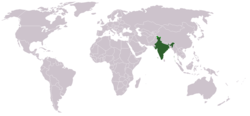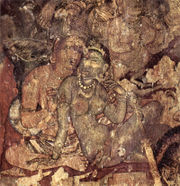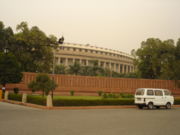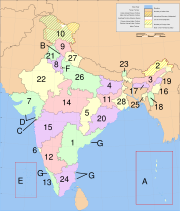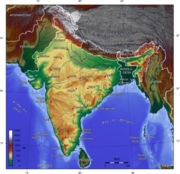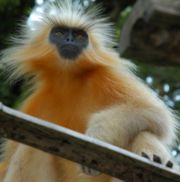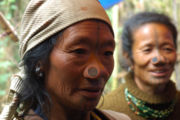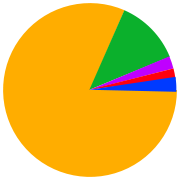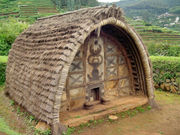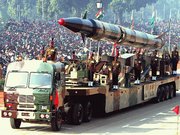India
2007 Schools Wikipedia Selection. Related subjects: Asian Countries; Countries
| भारत गणराज्य Bhārat Gaṇarājya Republic of India |
|||||
|
|||||
| Motto: Satyameva Jayate ( Sanskrit) Devanāgarī: सत्यमेव जयते ("Truth Alone Triumphs") |
|||||
| Anthem: " Jana Gaṇa Mana" listen |
|||||
| Capital | New Delhi |
||||
|---|---|---|---|---|---|
| Largest city | Mumbai (Bombay) | ||||
| Official languages | Hindi, English + 21 other official languages | ||||
| Government | Federal republic | ||||
| - President | A.P.J. Abdul Kalam | ||||
| - Prime Minister | Manmohan Singh | ||||
| Independence | from the UK | ||||
| - Declared | 15 August 1947 | ||||
| - Republic | 26 January 1950 | ||||
| Area | |||||
| - Total | 3,166,414† km² ( 7th) 1,222,559 sq mi |
||||
| - Water (%) | 9.56 | ||||
| Population | |||||
| - 2005 estimate | 1,103,371,000 ( 2nd) | ||||
| - 2001 census | 1,027,015,248 | ||||
| - Density | 329/km² ( 31st) 852/sq mi |
||||
| GDP ( PPP) | 2005 estimate | ||||
| - Total | $3.633 trillion ( 4th) | ||||
| - Per capita | $3,320 ( 122nd) | ||||
| GDP (nominal) | 2005 estimate | ||||
| - Total | $771,951 million ( 12th) | ||||
| - Per capita | $714 ( 134th) | ||||
| HDI (2004) | 0.611 (medium) ( 126th) | ||||
| Currency | Rupee (₨) ( INR) |
||||
| Time zone | IST ( UTC+5:30) | ||||
| - Summer ( DST) | not observed ( UTC+5:30) | ||||
| Internet TLD | .in | ||||
| Calling code | +91 | ||||
| † Includes only Indian-administered territory. | |||||
India ( Devanagari: भारत Bhārat), officially the Republic of India, is a country in South Asia. It is the seventh-largest country by geographical area, the second most populous country, and the most populous liberal democracy in the world. India has a coastline of over seven thousand kilometres, bounded by the Indian Ocean on the south, the Arabian Sea on the west, and the Bay of Bengal on the east. India borders Pakistan to the west; China, Nepal and Bhutan to the north-east; and Bangladesh and Myanmar to the east. In the Indian Ocean, India is in the vicinity of Sri Lanka, Maldives and Indonesia.
Home to the Indus Valley Civilization and a region of ancient trade routes and vast empires, the Indian subcontinent has a heritage that includes the decimal number system, the Buddhist art of Ajanta, and the Taj Mahal. Four major world religions, Hinduism, Buddhism, Jainism and Sikhism originated here, while Islam, Christianity, Judaism and Zoroastrianism, arrived in the first millennium CE and shaped India's variegated culture. Colonised by the British East India Company in the 18th century and directly administered by Great Britain starting the mid-19th century, India became a modern nation-state in 1947 after a struggle for independence marked by widespread use of nonviolent resistance as a means of social protest.
With the world's fourth largest economy in purchasing power and the second fastest growing large economy, India has made rapid progress in the last decade, most notably in information technology. A declared nuclear deterrent state, with an active space program, India is considered an emerging superpower. However, although its standard of living is projected to rise sharply in the next half-century, India currently battles high levels of poverty, persistent malnutrition, and environmental degradation. A multi-lingual, multi-ethnic society, India is home to a diversity of wildlife in a variety of protected habitat.
Etymology
The name India /'ɪndiə/ is derived from Indus, which is derived from the Old Persian word Hindu, from Sanskrit Sindhu, the historic local appellation for the Indus River. The Constitution of India and common usage also recognise Bharat /bʰɑːrət̪/ listen ), as an official name of equal status. A third name, Hindustan ( /hin̪d̪ust̪ɑːn/) listen ( Persian: Land of the Hindus ( Old Persian for Indus) has been used since the twelfth century, though its contemporary use is unevenly applied.
History
Stone Age rock shelters with paintings at Bhimbetka in Madhya Pradesh are the earliest known traces of human life on the Indian subcontinent. The first known permanent settlements appeared over 9,000 years ago, and gradually developed into the Indus Valley Civilization, dating back to 3300 BCE. It was followed by the Vedic Civilization which laid the foundations of Hinduism and other cultural aspects of early Indian society. From around 550 BCE, many independent kingdoms and republics known as the Mahajanapadas were established across the country.
The empire built by the Maurya dynasty under Emperor Ashoka united most of modern South Asia except the kingdoms in the south. From 180 BCE, a series of invasions from Central Asia followed including the Indo-Greeks, Indo-Scythians, Indo-Parthians and Kushans in the northwestern Indian Subcontinent. From the third century CE, the Gupta dynasty oversaw the period referred to as ancient India's "Golden Age." While the north had larger, fewer kingdoms, in the south there were several dynasties such as the Chalukyas, Cholas, Pallavas and Pandyas, overlapping in time and space. Science, engineering, art, literature, astronomy, and philosophy flourished under the patronage of these kings.
Following the invasions from Central Asia, between the tenth to the twelfth centuries, much of north India came under the rule of the Delhi Sultanate, and later the Mughal dynasty, who gradually expanded their reign through large parts of the Indian subcontinent. Nevertheless, several indigenous kingdoms flourished, especially in the south, like the Vijayanagara Empire. From the sixteenth century onwards, several European countries, including Portugal, Netherlands, France and the United Kingdom, started arriving as traders, later taking advantage of the fractious nature of relations between the kingdoms, to establish colonies in the country. By 1856, most of India came under control of the British East India Company. A year later, a nationwide insurrection of rebelling military units and kingdoms, known locally as the First War of Indian Independence (known as the Sepoy Mutiny elsewhere) broke out, which failed even as it seriously challenged British rule. As a consequence, India came under the direct control of the British Crown as a colony of the British Empire.
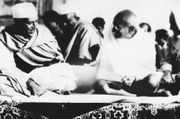
In the early twentieth century, a nationwide struggle for independence was launched by the Indian National Congress, largely led by Mahatma Gandhi. Millions of protesters would engage in mass campaigns of civil disobedience with a commitment to ahimsa or non-violence. Finally, on 15 August 1947, India gained independence from British rule not before losing its Muslim-majority areas which were carved out into a separate nation-state of Pakistan. Three years later, on 26 January 1950, India chose to be a republic, and a new Constitution came into effect.
Since independence, India has seen sectarian violence and insurgencies in various parts of the country, but has maintained its unity and democracy. It has unresolved territorial disputes with China, which escalated into the brief Sino-Indian War in 1962; and with Pakistan, which resulted in wars in 1947, 1965, 1971 and in 1999 in Kargil. India is a founding member of the Non-Aligned Movement and the United Nations (as part of British India). In 1974, India conducted an underground nuclear test. This was followed by five more tests in 1998. Significant economic reforms beginning in 1991 have transformed India into one of the fastest-growing economies and an emerging superpower in the world, and added to its global and regional clout.
Government
| Flag | Tiranga | |
| Emblem | Sarnath Lion | |
| Anthem | " Jana Gana Mana" | |
| Song | " Vandē Mātaram" | |
| Animal | Royal Bengal Tiger | |
| Bird | Indian Peacock | |
| Flower | Lotus | |
| Tree | Banyan | |
| Fruit | Mango | |
| Sport | Field Hockey | |
| Calendar | Saka |
The Constitution of India declares India to be a sovereign, socialist, secular, democratic republic. India has a federal form of government and a bicameral parliament operating under a Westminster-style parliamentary system. It has three branches of governance: the Legislature, Executive, and Judiciary.
The President is the head of state and Commander-in-Chief of India's armed forces; his role in governance is largely ceremonial. The President is elected indirectly by an electoral college for five-year terms. The Prime Minister is the de facto head of government and holds most executive powers. He or she is appointed by the President, with the requirement that he or she enjoys the support of the majority of the party or coalition securing the most number of seats in the lower house of Parliament.
The legislature of India is the bicameral Parliament, which consists of the upper house called the Rajya Sabha (Council of States), and the lower house called the Lok Sabha (House of People). The 245-member Rajya Sabha is chosen indirectly by the state legislative assemblies; members have staggered six-year terms. Each state sends members to the Rajya Sabha proportionate to its population. The Lok Sabha's 545 members are directly elected by popular vote for five-year terms, and is the determinative constituent of political power and government formation. All Indian citizens above age 18 are eligible to vote; voting is not mandatory.
The executive arm consists of the President, Vice-President, and the Council of Ministers (the Cabinet being its executive committee) headed by the Prime Minister. Any minister holding a portfolio must be a member of either house of parliament. In the Indian parliamentary system, the executive is subordinate to the legislature.
India's independent judiciary consists of the Supreme Court, headed by the Chief Justice of India. The Supreme Court has both original jurisdiction over disputes between states and the Centre, and appellate jurisdiction over the eighteen High Courts of India, and additionally, the power to declare Union and state laws null and void if in conflict with the Constitution.
Politics
For most of its independent history, India has been ruled by the Indian National Congress. The party enjoyed a parliamentary majority barring two brief periods during the 1970s and late 1980s. This rule was interrupted between 1977 to 1980, when the Janata Party coalition won the election owing to public discontent with the "Emergency" declared by the then Prime Minister Indira Gandhi. The Janata Dal won elections in 1989, but its government managed to hold on to power for only two years. Between 1996 and 1998, there was a period of political flux with the government being formed first by the right-wing nationalist Bharatiya Janata Party followed by a left-leaning United Front coalition. In 1998, the BJP formed the National Democratic Alliance (NDA) with smaller regional parties, and became the first non-Congress and coalition government to complete a full five-year term. The 2004 Indian elections saw the Congress party winning the largest number of seats to form a government leading the United Progressive Alliance, supported by left-leaning and other parties opposed to the BJP.
Since independence, India has maintained cordial relationships with most nations. It took a leading role in the 1950s by advocating the independence of European colonies in Africa and Asia. During the Cold War, India tried to maintain its neutrality and was one of the founding members of the Non-Aligned Movement. After the Sino-Indian War and the Indo-Pakistani War of 1965, India's relationship with the Soviet Union warmed at the expense of ties with the United States and continued to remain so until the end of the Cold War. Despite criticism and military sanctions, India has consistently refused to sign the CTBT and the NPT, preferring instead to maintain sovereignty over its nuclear program. Recent overtures by the Indian government have strengthened relations with the United States, China, and Pakistan. In the economic sphere, India has close relationships with other developing nations in South America, Asia, and Africa. In recent years, India has played an influential role in the ASEAN, SAARC, and the WTO. India has been a long time supporter of the United Nations, with over 55,000 Indian military and police personnel having served in 35 UN peace keeping operations deployed across four continents.
Administrative divisions
India is divided into twenty-eight states and seven federally-governed union territories. All states and the union territory of Pondichery have elected governments. The remaining five union territories have centrally-appointed administrators.
States:
|
Union Territories:
- Andaman and Nicobar Islands
- Chandigarh
- Dadra and Nagar Haveli
- Daman and Diu
- Lakshadweep
- Puducherry
- National Capital Territory of Delhi
All states and union territories are subdivided into districts. In larger states, districts may be grouped together to form a division.
Geography
India constitutes the major portion of the Indian subcontinent, which sits atop the Indian Plate and the northwesterly portion of the Indo-Australian Plate. India's northern and northeastern states are partially situated in the Himalayan Range. The rest of northern, central, and eastern India consists of the fertile Indo-Gangetic Plain. In the west, bordering southeastern Pakistan, lies the Thar Desert. Southern India is almost entirely composed of the peninsular Deccan plateau, which is flanked by two hilly coastal ranges, the Western Ghats and the Eastern Ghats.
India is home to several major rivers, including the Ganges, the Brahmaputra, the Yamuna, the Godavari, the Kaveri, the Narmada, and the Krishna. India has three archipelagos — Lakshadweep, which lies off the southwestern coast; the volcanic Andaman and Nicobar Islands island chain to the southeast, and the Sunderbans in the Ganges Delta of West Bengal.
The climate in India varies from tropical in the south to more temperate in the Himalayan north, where elevated regions receive sustained winter snowfall. India's climate is strongly influenced by the Himalayas and the Thar Desert. The Himalayas, along with the Hindu Kush mountains in Pakistan, prevent cold Central Asian katabatic winds from blowing in. This keeps the bulk of the Indian subcontinent warmer than most locations at similar latitudes. The Thar Desert is responsible for attracting the moisture-laden summer monsoon winds that, between June and September, provide most of India's rainfall.
Flora and fauna
India, lying within the Indomalaya ecozone, hosts significant biodiversity; it is home to 7.6% of all mammalian, 12.6% of avian, 6.2% of reptilian, and 6.0% of flowering plant species. Many ecoregions, such as the shola forests, also exhibit extremely high rates of endemism; overall, 33% of Indian plant species are endemic. India's forest cover ranges from the tropical rainforest of the Andaman Islands, Western Ghats, and Northeast India to the coniferous forest of the Himalaya. Between these extremes lie the sal-dominated moist deciduous forest of eastern India; teak-dominated dry deciduous forest of central and southern India; and the babul-dominated thorn forest of the central Deccan and western Gangetic plain. Important Indian trees include the medicinal neem, widely used in rural Indian herbal remedies. The pipal fig tree, shown on the seals of Mohenjo-daro, shaded the Gautama Buddha as he sought enlightenment.
Many Indian species are descendants of taxa originating in Gondwana, to which India originally belonged. Peninsular India's subsequent movement towards, and collision with, the Laurasian landmass set off a mass exchange of species. However, volcanism and climatic changes 20 million years ago caused the extinction of many endemic Indian forms. Soon thereafter, mammals entered India from Asia through two zoogeographical passes on either side of the emerging Himalaya. As a result, among Indian species, only 12.6% of mammals and 4.5% of birds are endemic, contrasting with 45.8% of reptiles and 55.8% of amphibians. Notable endemics are the Nilgiri leaf monkey and the brown and carmine Beddome's toad of the Western Ghats. India contains 172, or 2.9%, of IUCN-designated threatened species. These include the Asiatic lion, the Bengal tiger, and the Indian white-rumped vulture, which suffered a near-extinction from ingesting the carrion of diclofenac-treated cattle.
In recent decades, human encroachment has posed a threat to India's wildlife; in response, the system of national parks and protected areas, first established in 1935, was substantially expanded. In 1972, India enacted the Wildlife Protection Act and Project Tiger to safeguard crucial habitat; further federal protections were promulgated in the 1980s. Along with over 500 wildlife sanctuaries, India now hosts 14 biosphere reserves, four of which are part of the World Network of Biosphere Reserves; 25 wetlands are registered under the Ramsar Convention.
Economy
For most of its democratic history, India adhered to a quasi-socialist approach, with strict government control over private sector participation, foreign trade, and foreign direct investment. However, since 1991, India has gradually opened up its markets through economic reforms by reducing government controls on foreign trade and investment. Privatisation of publicly-owned industries and the opening of certain sectors to private and foreign participation has continued amid political debate.
With a GDP growth rate of 8.4%, the Indian economy is among the fastest growing in the world. It is the world's fourth largest as measured by purchasing power parity (PPP), with a GDP of US$3.63 trillion. However, when measured by USD exchange-rate terms, it is the twelfth largest in the world, with a GDP of US$785.47 billion. Wealth distribution in India, a developing country, is fairly uneven, with the top 10% of income groups earning 33% of all income. India's per capita income of US$3,400 is ranked 122nd in the world. Despite strong growth, the World Bank and others worry about the chronic federal and state budget deficits, currently approximately 9% of GDP.
India has a labour force of 496.4 million, 60% of which is employed in agriculture or agriculture-related industries. The service sector accounts for 23% of GDP; the agricultural and industrial sectors make up 22% and 17% respectively. Major agricultural crops include rice, wheat, oilseed, cotton, jute, tea, sugarcane, and potatoes. Major industries include textiles, chemicals, food processing, steel, transportation equipment, cement, mining, petroleum, and machinery. More recently, India has capitalised on its large pool of educated, English-speaking people to become an important outsourcing destination for multinational corporations. India has also become a major exporter of software as well as financial, research, and technology services. India's most important trading partners are the United States, the European Union, Japan, China, and the United Arab Emirates.
Demographics
With an estimated population of 1.1 billion, India is the world's second most populous country. Almost 70% of Indians reside in rural areas, although in recent decades migration to larger cities has led to the exponential rise in the urban population. India's largest urban agglomerations are Mumbai, Kolkata, Delhi, Chennai , Bangalore and Hyderabad.
India is home to two major linguistic families: Indo-Aryan (spoken by about 74% of the population) and Dravidian (spoken by about 24%). Other languages spoken in India come from the Austro-Asiatic and Tibeto-Burman linguistic families. The Indian constitution recognises 23 official languages. Hindi and English are used by the Union Government of India for official purposes, wherein Hindi has a de jure priority. Sanskrit and Tamil enjoy classical language status in India. The number of dialects in India is as high as 1,652.
Although 80.5% of Indians report themselves as Hindus, India's Muslim population is the world's second largest; they constitute 13.4% of the population. Other religious groups include Christians (2.3%), Sikhs (1.9%), Buddhists (0.8%), Jains (0.4%), Jews, Zoroastrians, and Bahá'ís.
At the time of India's independence in 1947, India's literacy rate was 11%. Since then, it has increased to 65.1% (54.3% for females and 75.3% of males). The state of Kerala has the highest literacy rate (91%); Bihar has the lowest (47%). The national sex ratio is 933 females per 1,000 males. One of the primary reasons for such a skewed ratio is the high prevalance of female infanticide, particularly in rural areas. India's median age is 24.66, and the population growth rate of 1.38% per annum; there are 22.32 births per 1,000 people.
Culture
India's culture is marked by a high degree of syncretism; it has managed to preserve established traditions whilst absorbing new customs, traditions, and ideas from invaders and immigrants. Many Indian cultural practices, languages, customs, and monuments are examples of this co-mingling over centuries. Famous monuments, such as the Taj Mahal and other examples of Islamic-inspired architecture, have been inherited from the Mughal dynasty. These are the result of traditions that combined elements from all parts of the country.
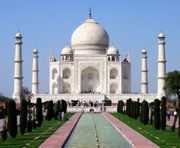
Indian music is highly diversified. Classical music is mainly split between the North Indian Hindustani and South Indian Carnatic traditions. Highly regionalised forms of popular music include Filmi and folk music like Bhangra. Many classical dance forms exist, including Bharatanatyam, Kathakali, Kathak, Kuchipudi, Manipuri, Odissi and Yakshagana. They often have a narrative form and are usually infused with devotional and spiritual elements. The earliest literary traditions in India were mostly oral, and were only later transcribed. Most of these are represented by religious texts such as the Vedas, the Mahabharata, and the Ramayana; Sangam literature from Tamil Nadu is among India's oldest. The many notable Indian writers of the modern era, using both Indian languages and in English, include Rabindranath Tagore. The Indian film industry is the world's most prolific; its most recognisable face is the Mumbai-based " Bollywood", which produces mainly Hindi films. Other strong cinema industries are based on the Punjabi, Kannada, Malayalam, Tamil, Telugu, and Bengali languages.
The cuisine of India is extremely diverse, as ingredients, spices and cooking methods vary from region to region. Rice and wheat are the nation's main staple foods. The country is notable for its wide variety of vegetarian and non-vegetarian cuisine. Spicy food and sweets are popular in India. Traditional Indian dress greatly varies across the regions in its colours and styles, and depend on various factors, including climate. Popular styles of dress include the sari for women and the lungi or dhoti for men.
India's national sport is field hockey, although cricket is now the de facto national game. In some states, particularly those in the northeast, football is the most popular sport and is widely watched. In recent times, tennis has gained popularity. Chess is also gaining popularity with the rise of the number of recognised Indian grandmasters. Chess, according to the most commonly held view, originated in India. Traditional indigenous sports include kabaddi, kho kho, and gilli-danda, which are played in most parts of the country.
Indian festivals come in a large variety; many are celebrated irrespective of caste and creed. The most widely celebrated include the Hindu festivals of Diwali and Holi, the Sikh festivals of Vaisakhi and Diwali the Muslim celebration of Eid ul-Fitr, Christmas of Christians and the Buddha_Purnima of Buddhism. India has three national holidays. Other sets of holidays, varying between nine and twelve, are officially observed in the individual states. Religious practices are an integral part of everyday life and are a very public affair. Traditional Indian family values are highly respected, although urban families now prefer a nuclear family system due to the socio-economic constraints imposed by the traditional joint family system.
Military of India
India maintains the third largest military force in the world. The armed forces of India consists of the Indian Army, Indian Air Force and the Indian Navy. There are auxillary forces like the Indian Paramilitary Forces, the Indian Coast Guard and the Strategic Forces Command. India is a declared nuclear weapons nation. The Indian Army maintains the second largest active troops in the world. The Indian Navy is the fifth largest in terms of manpower and the Indian Air Force is the fourth largest in the world.


